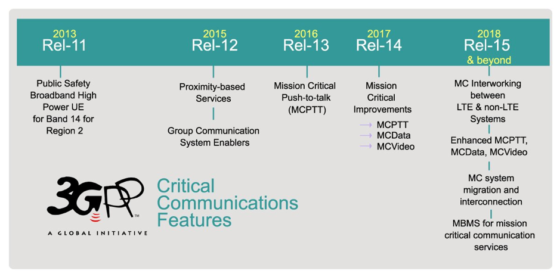Introduction to Broadband and Convergence
What is the Future of LTE?
LTE and the Mobile Generations
The LTE standards suite, which is setting the direction for future critical communications, is the work of a consortium of seven standards organizations called the 3GPP or third generation partnership program.
The consortium includes ETSI, the European Telecommunications Standards Institute, which is one of the largest standards bodies in the world. Since the end of the 90s, when the 3GPP consortium was formed, it has developed open standards for succession of LTE releases, guided by technical specifications set by ITU, the International Telecommunications Union for mobile cellular communications.
The evolution of mobile phone systems can be pictured in terms of generations:
0G– ‘Luggable’ briefcase mobile radio telephones (does anyone remember these?)
1G– Analog cellular phones
2G– Digital cellular phones
3G– High-speed digital cellular phones (including video comms)
4G– IP-based “anytime, anywhere” voice, data, and multimedia mobile comms at data rates that exceed 3G
5G– The Future. Still faster data rates, ultra-low latency, better mobility, more connections, and lower power consumption than 4G.
ITU’s technical specs set performance, data rate, and latency targets for 3G, 4G, and future 5G. The 3GPP designers have aimed to meet these standards. Each technology must improve on its predecessor. At the same time a major objective is, wherever possible, to make each technology backwards compatible with its predecessor so as minimize disruption when products entered the marketplace.
The first version of LTE (Release 8/9) exceeded the targets for 3G but did not reach the 4G targets. It is this version that you see in many early of the first ‘4G’ smartphones aimed at the consumer market. (Strictly speaking, these should be called ‘3.5G’ phones).
The next version, called LTE-Advanced (or LTE-A) achieves the 4G targets with data rates ten times faster than 3G. Newer 4G smartphones are already on LTE-A. It is this version which 3GPP is getting ready for critical communications users with features such as mission-critical PTT (MCPTT), MCDATA, MCVIDEO, and Direct Mode operation.
The final version of LTE is LTE Advanced Pro (LTE-A Pro) which sets the stage for 5G, the next generation of mobile communications for which standards have been finalized. LTE-A Pro is intended to be the LTE 4.5G technology transition to 5G, which uses some components from LTE and then other elements that are completely new. Equipment trials of LTE-A Pro and 5G have been underway and announcements of proposed commercial rollouts are already in the news.
 Radio Academy
Radio Academy





